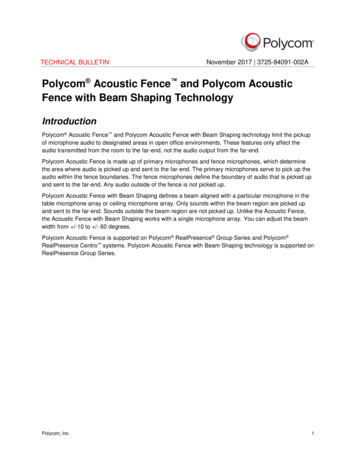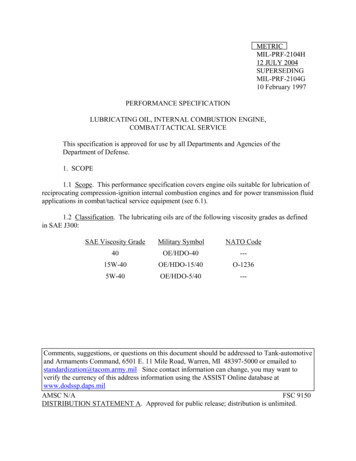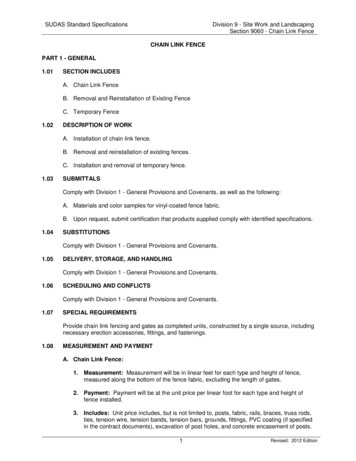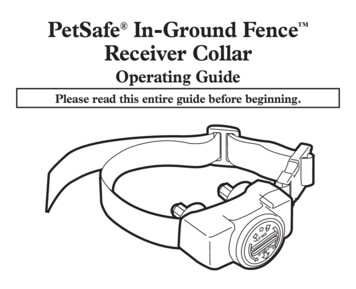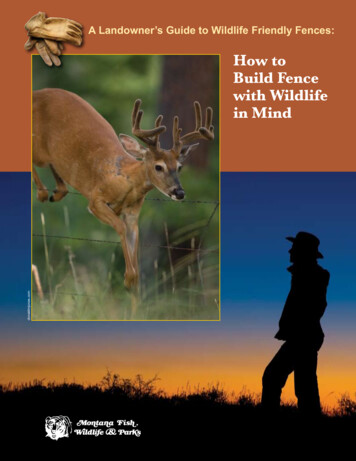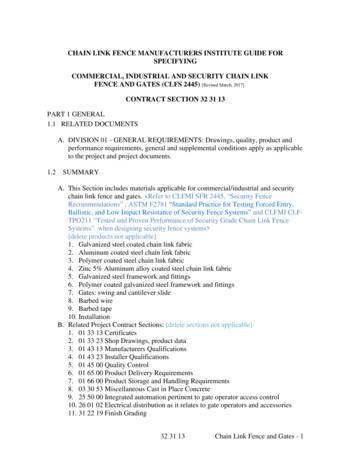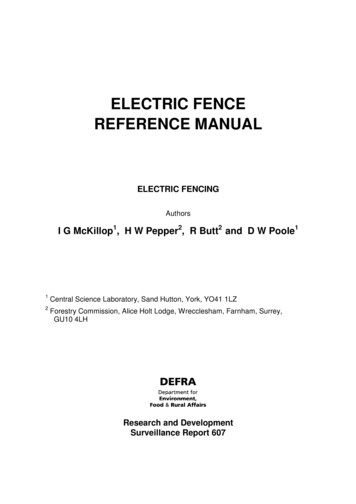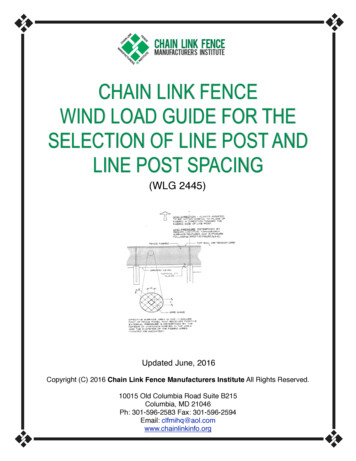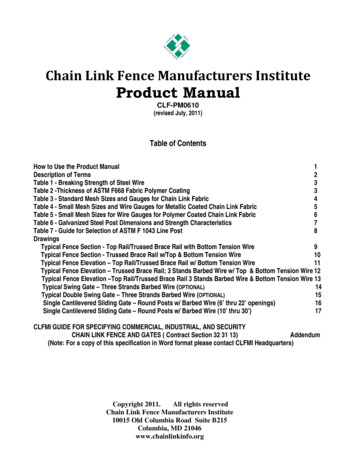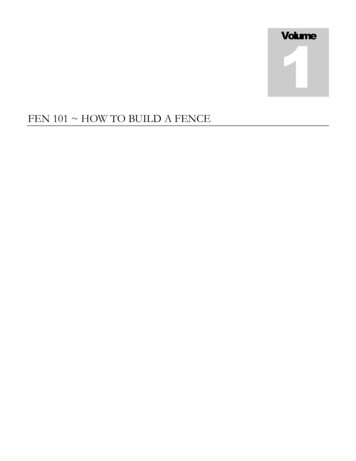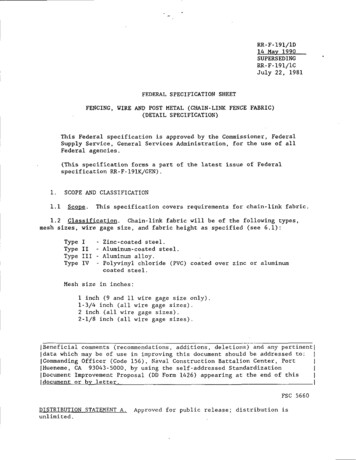
Transcription
RR- F-191/lD14May1990SUPERSEDINGRR- F-191/lCJuly 22, 1981FEDERAL SPECIFICATION SHEETFENCING , WIRE AND POST METAL (CHAIN-LINK FENCE FAfiRIC)(DETAIL SPECIFICATION)This Federal specification is approved by the Commissioner, FederalSupply Service, General Services Administration, for the use of allFederal agencies.(This specification forms a part of the latest issue of Federalspecification RR- F-191K/GEN)1.1.1SCOPE AND CLASSIFICATIONSS!22!2. This specification covers requirements for chain- link fabric.1.2Classification.Chain- link fabric will be of the following types,mesh sizes, wire gage size, and fabric height as specified (see 6.1) :TypeTypeTypeTypeI- Zinc-coated steel.II - Aluminum-coated steel.III - Aluminum alloy.IVPolyvinyl chloride (PVC) coated over zinc or aluminumcoated steel.Mesh size in inches :1 inch (9 and 11 wire gage size only)1-3/4 inch (all wire gage sizes)2 inch (all wire gage sizes)2-1/8 inch (all wire gage sizes)lBeneficial comments (recommendations, additions , deletions) and any pertinentIdata which may be of use in improving this document should be addressed to:ICommanding Officer (Code 156), Naval Construction Battalion Center, PortlHueneme , CA 93043-5000, by using the self-addressed StandardizationIDocument Improvement Proposal (DD Form 1426) appearing at the end of thisIdocument or by letter.FSC 5660DISTRIBUTIONunlimited.STATEMENT A.Approved for public release; distributionisI1III
RR- F-191/lDWire gage size outside diameter of metal corewirein inches:11 gage - 0.120 inches9 gage - 0.148 inches6 gage O. 192 inchesFabric height in hesinchesinchesinchesinchesinchesAPPLICABLE DOCUMENTSThe following other non-Government2.1 Non-Government documentsdocuments form a part of this specification to the extent specified herein.Unless otherwise specified, the issues are those cited in the solicitation. ASTM A 90- Test for Weight of Coating on Zinc-Coated (Galvanized)Iron or Steel ArticlesASTM A 370 - Mechanical Testing of Steel ProductsASTM A 428 - Tests for Weight of Coating on Aluminum-Coated Iron orSteel ArticlesAluminum-Alloy Bars , Rods , and WiresASTM B 211Operating Light -and-Water- Exposure Apparatus (Carbon-ArcASTM D 1499Type) for Exposure of PlasticsASTM D 1535 - Specifying Color by the Munsell System.ASTM D 1729 - Visual Evaluation of Color Differences of OpaqueMaterialsASTM G 23Operating Light and Water-Exposure Apparatus (Carbon-ArcType) for Exposure of Nonmetallic Materials.ASTM G 26- Operating Light and Water- Exposure Apparatus) Xenon-ArcT pe) fo Ex&sure of Nonmet llic Ma rials(Application for copies should be addressed to the ASTM, 1916 Race Street,Philadelphia, PA 19103. )3.REQUIREMENTS3,1 FabricThe chain-link fence fabric shall be helically woven into adiamond mesh. Fabric shall be woven from the type of wire, mesh size and wiregage size, and to the height selected (see 1.2 and 6.1)
RR- F-191/lDUnless otherwise specified (see 6.1) the steel wire for3.2Steelwire.the fabric shall be of such quality and purity that, when drawn to the wiregage size specified, the wire shall have a minimum tensile strength of75,000 pounds per square inch when tested in accordance with 4.4.3. Thebreakload for steel is: 11 gage - 850 pounds; 9 gage -.1290 pounds; and6 gage - 2170 pounds. The breakload for aluminum alloy is 9 gage - 925 pounds;6 gage - 1560 pounds.3.3 Wire caee size. Wire for fabric shall be of the wire gage sizeselected (see 1.2 and 6.1)The outside diameter cited in 1.2 is the metalwire diameter allowable for that wire gage size and includes the metalliccoating. When type IV wire is required, the wire gage size shall be that ofthe core wire only, the PVC coating shall not be considered when determiningwire size. Tolerance for wire size 0.005 inches.3.4 Type 1, zinc-coated steel wire. Unless otherwise specified (see 6 .1),the minimum weight of coating on the wire shall be 1.2 ounces of zinc persquare foot of coated surface area when determined in accordance with 4.4.2.1.3.5 Twe 11. aluminum-coated steel wire. The minimum weight of aluminumcoating for 6- and. 9 -gage wire shall be O.4. ounces per square foot. Theminimum weight of aluminum coating for 11-gage wire shall be O.35 ounces persquare foot. Weight of aluminum shall be determined in accordance with 4.4.2.2.3.6Tvue III . aluminum alloy wire. The aluminum wire shall conform to therequirements of ASTM B 211, alloy 6061 -T94.3.7 Tme IV. PVC coated over zinc or aluminum coated steel wire. The PVCcoating shall meet the requirements of 3 .7.1 thru 3.7.4. Minimum thickness Ofthe PVC coating shall be 0.007 inches as determined in 4.4.4.1. Unless otherwise specified (see 6.1) , the method of applying the PVC coating (see 6 .4) shallbe the manufacturer’s option. Minimum weight of zinc coating on the steel wireshall be 0.4 ounces per square foot for 6 gage and O 3 ounces per square footwireshall meet the requirements offor 9 and 11 gage. Aluminum coated steel3.5.3.7.1 Color of PVC-coated wire. The color of PVC-coated wire shall be oneof the standard colors cited in table I as specified (see 6.1)When colorsnot cited in table I are required, the color shall be as specified (see 6.1)TABLE 1.Munsell Units (ASTM D 1535 and D 1729)IIIHueIValueIChromaColor of PVC coated fabric wireMedium EreenDark creen8.8G2.635.82.OG3.022.35I31.8PB1.26I0.5I
RR- F-191/lD3.7.2 Weaveabilitv to PVC coated wire. PVC coated wire shall be capableof being woven in to fabric without the PVC coating cracking, crazing, orpeeling.3.7.3 Accelerated ageing of PVC coatines . PVC coatings shall not shrinkmore than 1/16 inch per foot of length, demonstrate a significant visual changein color or gloss, or exhibit breaks, cracks, crazing, crumbling, or othervisual forms of failure when tested in accordance with 4.k.4.2.3.7.4 Flexibility of PVC coating. PVC coating shall demonstrate flexibilityby exhibiting no breaks, cracks, crazing, crumbling, or other visual fOrms Offailure of the coating when tested in accordance with the mandrel bend test of4.4.4.3.3.8 Mesh size. The mesh size for fabric shall be one of the sizesselected (see 1.2)The mesh size shall be the inside measurement of thediamond shape of the tensioned fabric as determined in 4.3.2. Tolerance formesh size is fl/8 of an inch.3.9 Diamond count, Unless otherwise specified (see 6.1) , the diamondcount shall be the manufacturer’s standard. All diamond counts shall beconsistent within a lot.3.10 Selvare. Unless otherwise specified (see 6 .1), the fabric will befurnished with standard selvages as follows:(a) Fabric up to and including 60 inches high with 2-inch mesh shall beknuckled at the top and bottom selvages(b) Fabric over 60 inches high with 2-inch mesh shall be twisted andbarbed on the top selvage and knuckled on the bottom selvage.(c) Fabric of all heights with l-inch or 1-3/4 inch mesh shall beknuckled at the top and bottom selvagesWhen specified (see 6 .1), fabric shall be provided with one of the followingselvage types:(a) Knuckled at both selvages(b) Knuckled at one selvage and twisted and barbed at the other.(c) Twisted and barbed at both selvages , except on fabric with 1-inchmesh.3.10.1 Knuckled.Loops of knuckled selvage shall be closed or nearlyclosed with a space not exceeding the diameter of the wire3.10.2 Twisted and barbed. Wire shall be twisted in a closed helix of1-1/2 machine turns equivalent to three full twists, and cut at an angle toprovide sharp barbsThe wire ends beyond the twist shall be at leasti/4-inch long (see 4.3.3)3.11 Fabric height.Fabric height shall be of the selected il inch (see 1.2and 6 .1), as determined by 4 3,4. Tolerance for fabric height is il inch.
RR- F-191/lD3.12 Fabric lenzth. Unless otherwise specified (see 6.1) , the standardlength of fabric roll shall be 50 linear feet fl percent as determined by4.3.5. Each roll of fabric shall be a one-piece length.4.QUALITY AS SUSLANCE PROVI SIONSResponsibilityfor inspection.4.2Samul ing.(See RR- F-191K/GEN, section 6.4.3Samuling.(See 6.4)&.4Examination.Examine fabric for defects listed in table II.TABLE II.I(See RR-F 191K/GEN)4.1Classificationof defects.MajorDefectsMinorIIlHeight of fabric not as specified.IDiamond count not as specified.lLength of wire not as specified.ISize of wire not as specified.ISize of wire not as specified.lType of wire not as specified.I?,elvagenot as specified.Icolor not as specified.IBarbs on twisted and barbed selvage not sharp.IFrozen joints on zinc-coated fabric.ICoating cut, scratched, or abraded exposing bare wire.cracked, crazed. or ueelinz.]Plastic coatingxxxxxxxxxxxx4.3.1 Wire gaee. Determine the diameter of types 1, 11, and 111 wire byaveraging two diameter measurements of the wire taken at right angles to eachother (see 1.2 and 3.3. ) The diameter of type IV wire shall be determined asabove after removal of the PVC coating.4.3.2Size of mesh. Measure the clear distance in either directionbetween the wires forming the parallel sides of the mesh taking the mean oftwo dimensions at right angles to each other (see 1.2 and 3 .8)4.3.3 Length of barbs. Measure the wire ends along the inside of thetwist from the last twist to the tip of barbs in twisted and barbed selvage(see 3.10.2).4. 3.4 HeiEht of fabricMeasure the height with tension applied, betweenouter extremities of the fabric, including the overall dimension form ends ofbarbs or knuckles (see 3.11)4.3.5 Len th of fabric. When in rolls, measure the length by unrollingthe rolls on a flat surface and apply tension to remove slack. Tension appliedshall not reduce the actual height of tbe fabric by more than 1/16 inch per footof height or by more than 1/2 inch in overall height, whichever is less(see 3.12).5
RR-F-191/lD4.4Test methods4.&. 1 SpecimensAt least two specimens for each test shall be obtainedfrom one linear foot of fabric cut from one of the rolls selected in accordancewith 4.2.4 .4.2Weivht and thickness of metallic coatin?s4.4.2.1Zinc coat.(see 3.4 and 3.7).Determine weight of zinc in accordance with ASTM A 904.4.2.2 Weizht of aluminum coat.accordance with ASTM A 428 (see 3.5)Determine weight of aluminum coating in4.4.3 Tensile test of steel wire. The steel wire shall be tested fortensile strength in accordance with ASTM A 370 (see 3.2)4.4.4PVC coatine tests.4.4.4.1PVC coatine thickness. Determine thickness of PVC coating bystripping the coating and measuring the diameter of the wire as in 4.3.1.One-half the difference between this measurement and the outside diameter ofthe coated wire will be used to determine the thickness 0! the cOating forconformance to 3.7.4.4.4.2 Accelerated a ine of a PVC coated wire. A sample of PVC coatedwire from which the fabric is woven shall be subjected to accelerated aging byexposure for 1,000 hours at a black panel temperature of 145% 9% Fahrenheit (F)(63% *5% Celsius (c)) i“ accordance with ASTM D 1499. The apparatus used tOperform this test shall be either ASTM G 23, Type D, E, F, or HH or ASTM G 26,type BH. After completion of this aging, the coated wire shall be examined todetermine compliance with 3.7.3. Shrinkage of the coating of more than1/16 inch per foot of length, significant visual change in color or gloss, orbreaks, cracks, crazing, crumbling, or other visual forms of failure shall beIn addition, samples of the coated wire which havecause for rejection.completed this aging process must meet the requirements of the mandrel bendtest of 4.4.4.3.4.4.4.2.1Frequency of test. Unless otherwise specified (see 6.1) , thetest for accelerated aging shall be performed on the initial inspection, andthereafter only when changes are made in the PVC coating.4.4.4.3 Mandrel bend test. After the sample has been subjected to theaccelerated aging of 4.4.4.2, it shall be tested as follows: A 12- inch lengthof PVC coated wire removed from the fabric , including bends and straightsections , but not including twists or knuckles , shall be used as the sample.This sample shall be cold soaked at -20%F (-29kC) for 1 hour. The sampleshall be removed from the cold source and within 30 seconds wrapped around amandrel one complete turn (360%)The mandrel shall have a maximum diameter of10 times the outside diameter of the wire being tested. The coating on thewire shall exhibit no breaks , cracks , crazing, crumbling or other visual formsof failure after completion of this test (see 3.7.4)6
RR- F-191/lD5.PREPARATION6.NOTESFOR DELIVERY (See RR-F- 191K/GEN)(This section contains information of a general or explanatory nature thatmay be helpful, but is not mandatory. )6.1 Ordering data. Purchasers should select the preferred optionspermitted herein and include the following information in , number, and date of this specification.Issue of DODISS to be cited in the solicitation, and if required,the specific issue of individual documents referenced (see 2.1)Size required (see 1.2)When first article is required for inspection and approval (see3.1).Type, mesh size, wire gage size, and fabr’icheight required (see1.2, 3.3, 3.8, and 3.11).When the steel wire is other than specified (see 3.2) .When weight of zinc coating is other than specified (see 3 .4).When method of applying the PVC coating is not manufacturers optionand method specified (see 3.7 and 6.4) .Color of PVC coated wire is other than cited and color required(3.7.1).When color of PVC coated wire is other than cited and colorrequired (see 3.7. 1)When diamond counts are not as specified and diamond count required(see 3.9).Type of selvage if other than standard (see 3.10)Length of fabric if other than standard (see 3.10)Frequency of test for accelerated aging of PVC coated wire (see4.4.4.2.1).6.2 Zinc-coated fabric. The surface of zinc coatings, particularlythose produced by hot-dip galvanizing, are not always smooth and devoid ofirregularitiesSuch irregularities ordinarily do not warrant rejection ofzinc-coated fabric. Thickness of the zinc coat can be determined, us
ASTM B 211 ASTM D 1499 ASTM D 1535 - ASTM D 1729 - ASTM G 23 ASTM G 26 - Test for Weight of Coating on Zinc-Coated (Galvanized) Iron or Steel Articles Mechanical Testing of Steel Products Tests for Weight of Coating on Aluminum-Coated Iron or Steel Articles Aluminum-Alloy Bars, Rods, and Wires Operating Light-and-Water-Exposure Apparatus (Carbon-Arc Type) for Exposure of Plastics
